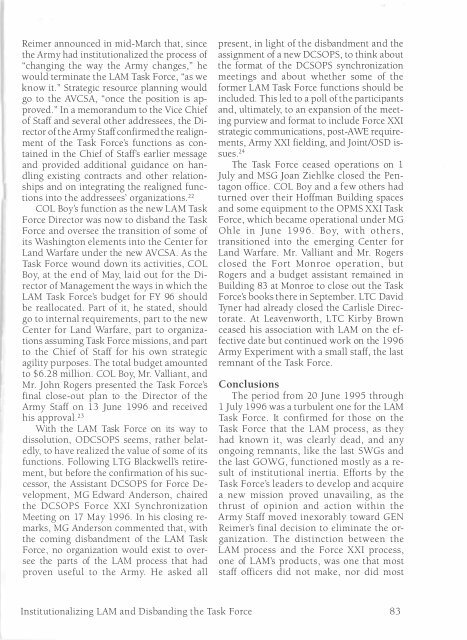The Modern Louisiana Maneuvers - US Army Center Of Military History
The Modern Louisiana Maneuvers - US Army Center Of Military History
The Modern Louisiana Maneuvers - US Army Center Of Military History
You also want an ePaper? Increase the reach of your titles
YUMPU automatically turns print PDFs into web optimized ePapers that Google loves.
Reimer announced in mid-March that, since<br />
the <strong>Army</strong> had institutionalized the process of<br />
"changing the way the <strong>Army</strong> changes," he<br />
would terminate the LAM Task Force, "as we<br />
know it." Strategic resource planning would<br />
go to the AVCSA, "once the position is approved."<br />
In a memorandum to the Vice Chief<br />
of Staff and several other addressees, the Director<br />
of the <strong>Army</strong> Staff confirmed the realignment<br />
of the Task Force's functions as contained<br />
in the Chief of Staff's earlier message<br />
and provided additional guidance on handling<br />
existing contracts and other relationships<br />
and on integrating the realigned functions<br />
into the addressees' organizations 22<br />
COL Boy's function as the new LAM Task<br />
Force Director was now to disband the Task<br />
Force and oversee the transition of some of<br />
its Washington elements into the <strong>Center</strong> for<br />
Land Warfare under the new AVCSA. As the<br />
Task Force wound down its activities, COL<br />
Boy, at the end of May, laid out for the Director<br />
of Management the ways in which the<br />
LAM Task Force's budget for FY 96 should<br />
be reallocated. Part of it, he stated, should<br />
go to internal requirements, part to the new<br />
<strong>Center</strong> for Land Warfare, part to organizations<br />
assuming Task Force missions, and part<br />
to the Chief of Staff for his own strategic<br />
agility purposes. <strong>The</strong> total budget amounted<br />
to $6.28 million. COL Boy, Mr. Valliant, and<br />
Mr. John Rogers presented the Task Force's<br />
final close-out plan to the Director of the<br />
<strong>Army</strong> Staff on 13 June 1996 and received<br />
his approval.23<br />
With the LAM Task Force on its way to<br />
dissolution, ODCSOPS seems, rather belatedly,<br />
to have realized the value of some of its<br />
functions. Following LTG Blackwell's retirement,<br />
but before the confirmation of his successor,<br />
the Assistant DCSOPS for Force Development,<br />
MG Edward Anderson, chaired<br />
the DCSOPS Force XXI Synchronization<br />
Meeting on 17 May 1996. In his closing remarks,<br />
MG Anderson commented that, with<br />
the coming disbandment of the LAM Task<br />
Force, no organization would exist to oversee<br />
the parts of the LAM process that had<br />
proven useful to the <strong>Army</strong>. He asked all<br />
present, in light of the disbandment and the<br />
assignment of a new DCSOPS, to think about<br />
the format of the DCSOPS synchronization<br />
meetings and about whether some of the<br />
former LAM Task Force functions should be<br />
included. This led to a poll of the participants<br />
and, ultimately, to an expansion of the meeting<br />
purview and format to include Force XXI<br />
strategic communications, post-AWE requirements,<br />
<strong>Army</strong> XXI fielding, and Joint/OSD issues.24<br />
<strong>The</strong> Task Force ceased operations on 1<br />
July and MSG Joan Ziehlke closed the Pentagon<br />
office. COL Boy and a few others had<br />
turned over their Hoffman Building spaces<br />
and some equipment to the OPMS XXI Task<br />
Force, which became operational under MG<br />
Ohle in June 1996. Boy, with others,<br />
transitioned into the emerging <strong>Center</strong> for<br />
Land Warfare. Mr. Valliant and Mr. Rogers<br />
closed the Fort Monroe operation, but<br />
Rogers and a budget assistant remained in<br />
Building 83 at Monroe to close out the Task<br />
Force's books there in September. LTC David<br />
Tyner had already closed the Carlisle Directorate<br />
. At Leavenworth , LTC Kirby Brown<br />
ceased his association with LAM on the effective<br />
date but continued work on the 1996<br />
<strong>Army</strong> Experiment with a small staff, the last<br />
remnant of the Task Force.<br />
Conclusions<br />
<strong>The</strong> period from 20 June 1995 through<br />
1 July 1996 was a turbulent one for the LAM<br />
Task Force. It confirmed for those on the<br />
Task Force that the LAM process, as they<br />
had known it, was clearly dead, and any<br />
ongoing remnants, like the last SWGs and<br />
the last GOWG, functioned mostly as a result<br />
of institutional inertia. Efforts by the<br />
Task Force's leaders to develop and acquire<br />
a new mission proved unavailing, as the<br />
thrust of opinion and action within the<br />
<strong>Army</strong> Staff moved inexorably toward GEN<br />
Reimer's final decision to eliminate the organization.<br />
<strong>The</strong> distinction between the<br />
LAM process and the Force XXI process,<br />
one of LAM's products, was one that most<br />
staff officers did not make, nor did most<br />
Institutionalizing LAM and Disbanding the Task Force 83
















